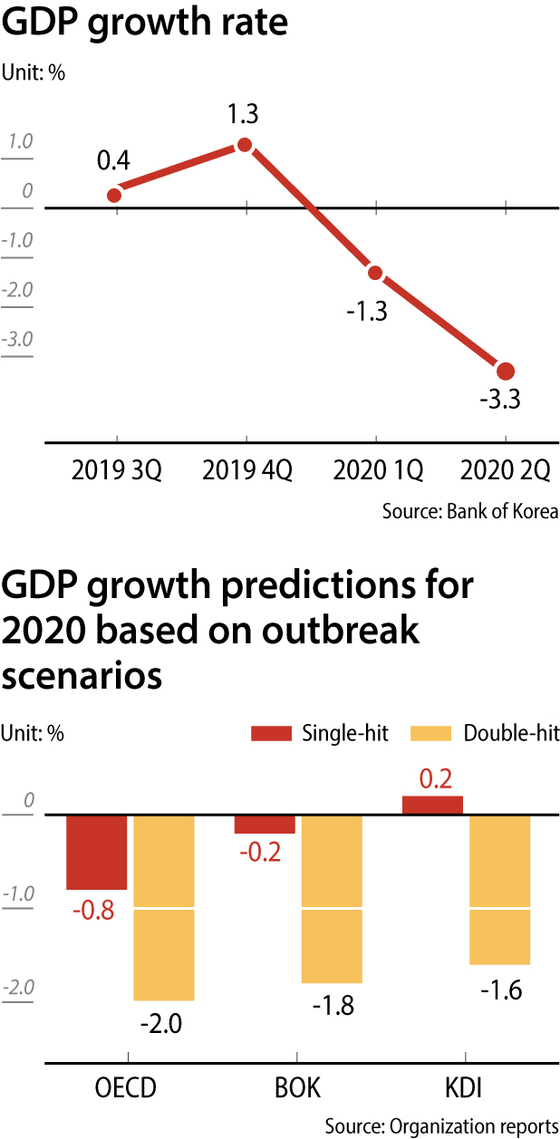V-shaped rebound hopes dashed by Covid-19 double-hit

If this is in fact the dreaded second wave, worst-case scenarios are going to have to be dusted off.
On Aug. 11, President Moon Jae-in echoed the Organisation for Economic Cooperation and Development’s (OECD) projection that Korea faces the smallest economic contraction among advanced countries this year.
“Korea has become an exemplary country that succeeded in disinfection without closing the country. Korea is expected to achieve the highest growth rate among the 37 OECD member nations,” said President Moon.
Just a week after this statement, a resurgence in coronavirus cases raises concern about a prolonging of the economic downturn and begins to bring into doubt the possibility of a recovery beginning in the third quarter after contractions in the first and the second.
The OECD’s original projection of negative 0.8 percent growth in 2020 put Korea at the top of the organization's league table. No other country in the OECD was seen growing as fast.
With the analysis, the group also offered a projection that assumes a "double-hit" scenario, in which the virus returns and cases increase after the original peak in numbers.
The double-hit projection of Korea is a minus 2.0 percent growth. Though it still puts Korea at the top of the rankings, it puts an end to the hope for a quick recovery.
Other organizations and institutions are coming out with similar projections. The Bank of Korea (BOK) earlier forecast a 0.2 percent downturn. Taking into account the possibility that the number of cases will rise in the third quarter, the forecast is minus 1.8 percent.
The Korea Development Institute (KDI) predicted 0.2 percent growth in 2020, but that is based on the assumption that domestic demand will recover. In the scenario where domestic demand and exports both suffer, KDI’s growth projection is a minus 1.6 percent.
Some critics say that the administration’s hope for a V-shaped rebound is already a lost cause. They add that the government’s focus on economic recovery via consumption campaigns as well as a lax approach to virus prevention have led to the resurgence in cases.
“The second major spread of the virus has essentially begun,” said Sung Tae-yoon, an economics professor at Yonsei University. “There will be a further downturn in the economy, since exports will continue to get worse, and consumption, which briefly picked up in the first half, will inevitably decline.”
The situation could be worse than in the beginning stages of the coronavirus pandemic. Some warn that the latter half of the year is the beginning of the real crisis. Consumption and state finances, two factors that prevented the economy from collapsing, have become vulnerable.
On Aug. 15, the central government raised the three-tiered social distancing levels for Seoul and Gyeonggi from Level 1 to Level 2, effective on the 16th. On Tuesday, it went further and said many measures that were “recommended” at the Level 2 system will now be compulsory, or “forced.”
The possibility of Level 3 cannot be ruled out. At Level 3, group gatherings of more than 10 people are banned. Schools will return to remote learning, and work-from-home will be recommended for non-essential workers. Many major firms have already started working remotely. The Ministry of Agriculture, Food and Rural Affairs and the Ministry of Culture, Sports and Tourism have halted their discount and coupon campaigns that are aimed at boosting demand.
State finances are approaching the danger point after the series of supplementary budgets that went into effect in the first half. According to the Ministry of Economy and Finance, the cumulative deficit has spiked up to 110.5 trillion won ($93.5 billion). The rapid increase was due to the substantial amount of money that was used in the three supplementary budgets, totaling 59 trillion won during the initial stages of the outbreak.
The government has spent 277 trillion won responding to the coronavirus crisis in the main and supplementary budgets. It is also spending on the restoration of areas flood damaged during the record-long wet season this year. There have been talks about a fourth supplementary budget, but no progress has been made because of how much the additional budgets have strained the government’s balance sheet.
“Prematurely spending the money was an issue, but how it was used was the bigger issue,” said Kim Sang-bong, an economics professor at Hansung University. “When the country approves supplementary budgets, they should be centered around fundamental aspects like disinfection and hygiene.”
“The government should have ensured that the public feels safe after establishing strong prevention and sanitation structures, so that people know that they are guaranteed treatment if they fall sick,” Kim added. “The government spent too much money to boost consumption when the outbreak was not completely managed.”
If this round of resurgence spirals out of control, the lower forecasts will have to be used.
“This year’s economy has plunged, which may lead to difficulties in acquiring tax revenues to sustain next year. This level of government spending will be difficult,” said Kim Jung-sik, an economics professor at Yonsei University. “Effects of the decrease in exports will take some time to be visible, so Korea’s export-heavy economy may face real challenges in the second half of the year.”
“Obtaining funds will become increasingly difficult, so expenses like the disaster relief funds should be avoided,” said Sung. “Specialized support for vulnerable populations as well as companies and the self-employed must be available in case the situation becomes worse.”
BY CHO HYUN-SOOK, KIM NAM-JOON [lee.jeeyoung1@joongang.co.kr]










with the Korea JoongAng Daily
To write comments, please log in to one of the accounts.
Standards Board Policy (0/250자)